Table of Contents
Every one connected with a mine knows that it is hard to keep down the costs of moving ore from the place where it is broken to the shaft or portal. Considered broadly, the subject of handling would cover all work done in a mine but here it has been limited to handling ore in stopes and drifts, through chutes, and on levels. Good ventilation and a strict enforcement of rules for the prevention of dust safeguard the health of the men and lower transportation costs.
HANDLING ORE IN STOPES AND DRIFTS
The object of all stoping is to mine ore of good grade at low cost. In Butte, the major part of the ore is mined, from veins dipping from 60° to the horizontal to those which are vertical, by means of square-set, rill, timbered-rill, and back-filling stopes. When blasted, a part of the rock is carried by gravity to the grizzlies over the chutes, the rest is shoveled.
Rock, when broken in a stope, may be deflected by inclined floors or slides toward the top of a chute leading to the level below. Ore broken clean enough to ship should be carried, by the force of its fall, into a chute or as nearly into that chute as the safety of the stope and the men permits. Ore that requires sorting, about 80 per cent, of all ore mined, is caught on a grizzly and the waste picked out. Waste rock broken in a stope is used to fill that stope and should be blasted into the gob with as little handling as possible.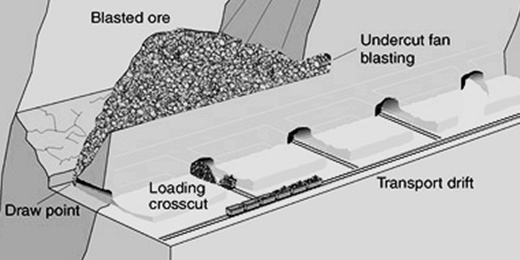
About two-thirds of all the ore mined in Butte comes from square-set stopes; this method was used in nearly all cases until 1912, when the rill method of stoping was introduced in the Tramway mine, of the Anaconda Copper Mining Co. The shoveling and timbering costs in square-set stopes are high when compared with the costs in the rill stopes. All the ore cannot be carried to the chute, in falling from place, unless the chutes are very close together or the distance from the back of the stope to the top of the chute is sufficient to slide all the ore broken. The number of chutes is limited by the tendency of the ground to cave; if carried too close together the stope is weakened. Small stopes, or blocks, as they are called, are used in working a large orebody, as they stand better and allow more of the ore to be handled on slides.
The rill stope is growing in favor throughout the district. These stopes are filled with waste from a chute at the upper end and floors are laid on this waste. The ore is drilled and blasted to the floor, which is from 40 to 45° to the horizontal, and runs to the grizzly at the lower end of the stope at a minimum cost for handling.
The timbered-rill is a rill stope with square-set timbering; it is used where the vein is too wide and the back is considered unsafe for the open rill method. These stopes are filled and the ore is removed as in the open rills. The broken ore is drawn into the chute as cheaply, save for some interference by the stope timbers to its passage down the floors.
The back-filling stope is worked without timber between chutes. The floors are level, as in the square-set stopes, yet rest on the waste filling as in the rills. Except where the veins are very flat, under 50°, the back-filling stope has been supplanted by the open rill.
Shoveling
Laying good floors and slides and careful sorting on the grizzlies are more important in a stope than using a shovel to put rock into the chute. Actual shoveling costs vary so much for the different mines, as well as for the individual stopes in any one mine, that an accurate statement of shoveling will not be given. The results given here are from the cost sheets for some of the larger mines over a 4-yr. period.
COMPARATIVE SHOVELING COSTS FOR DIFFERENT METHODS OF STOPING
Square-set stoping……………………………………………..100
Rill stoping…………………………………………………………75
Timbered-rill stoping………………………………………….85
Back-filling stoping……………………………………………120
These results show that: The rill stope is the most economical; the timbered-rill stope makes the application of the rill principle more general. The back-filling stope is used to meet special conditions, the square-set stope is still used in heavy ground and where large orebodies are to be worked in blocks.
All the ore broken in drifts is shoveled into cars. The amount shoveled per man depends on car service, distance to be trammed by the shovelers, condition of cars and track, and ventilation, as well as the ability of the men. Slight delays in getting cars sometimes cause considerable losses in efficiency; for instance, two men who have averaged over fifty cars per shift (35 tons) shoveled, trammed, and dumped into a chute may shovel but thirty cars when moved to another drift, because of bad tracks, stiff cars, poorly trained men on trains, etc. The well-trained shoveler of exceptional physique can overcome unfavorable working conditions, but good car service, ventilation, and equipment must be maintained if the average man is to do a satisfactory shift’s work.
If a drift or crosscut is timbered to the breast, because of heavy ground, floors are laid on sills or spreaders; if untimbered, turn sheets of ¼-in. steel plate are placed against the breast to receive the broken ore. About 70 per cent, of the ore broken in drifts is shoveled from floors or turn sheets, the remainder from the rough bottom. From 12 to 18 tons per man shift are shoveled in drifts and crosscuts.
A No. 2 shovel with a straight handle 42 in. long is used throughout the district, short shovels with a D-shaped handle were tried but were not liked by the miners. The tools used in shoveling are: No. 2 square-point or round-point shovel; No. 4 picks; 12-lb. rock hammers; No. 4 steel wheelbarrows; Anaconda typemine cars. The grizzlies are timber or steel rails spaced 4 to 10 inches.
HANDLING ORE IN CHUTES
When an orebody is encountered, in developing a new level, square sets are used to timber the level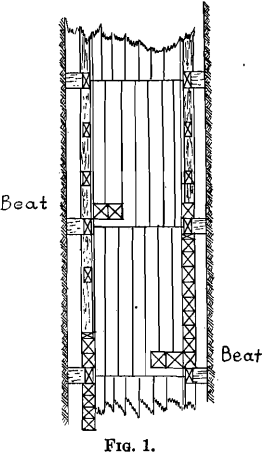 along the vein, or the sill floor, as it is called. Enough work is done on the sill to determine the quality of the ore and the method of stoping that should be adopted. The location of the raises is then decided and one is started as soon as possible to improve ventilation.
along the vein, or the sill floor, as it is called. Enough work is done on the sill to determine the quality of the ore and the method of stoping that should be adopted. The location of the raises is then decided and one is started as soon as possible to improve ventilation.
If square-set stopes are to be used, a raise with one chute may be selected as it will stand better in heavy ground. As few veins are vertical, the raise timbers follow the foot wall and offset from time to time. This means that a floor standing vertically above the one below will be timbered with six posts; the offset floors, with nine or twelve posts. When the chutes are built, these offsets, by breaking the fall of the ore, reduce the wear on the chute lining. If a chute is vertical, false offsets or beats, Fig. 1, may be used. The ore mined in driving a raise of this type must be sorted at the chute mouth on the level.
Sometimes a larger raise is used; two chutes may be carried and sorting landings built in the chute sets. Fig. 2 shows a raise of this type. Each chute is used as for ore alternately and waste picked off the grizzly is thrown into the other chute. These large raises are usually driven in connection with rill stoping: their larger cross section insures better ventilation, the two chutes permit closer sorting of the comparatively large tonnage mined while the raise is being driven, and, later, waste is furnished the rills without building slides across the raise manway.
In laying out rill stopes, raises are driven at regular intervals along the vein as each raise will, when holed, furnish waste to two rills. If back-
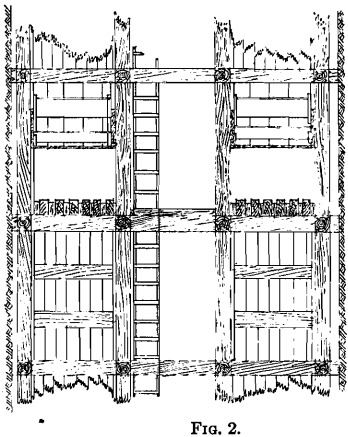
filling stopes are to be used, the raises are timbered with square sets but stope chutes are sometimes built of log-cabin cribbing. Stoping starts and stope chutes are built after the raises are holed to the level above. The lower floors of all chutes are solidly built and the square sets of both chute and manway are well braced. Transfer chutes are often driven without timber, in solid ground, away from the vein.
Stope chutes and transfer chutes, once a great source of dust, are kept wet. Water is piped to nearly every stope and as the dry stoping machines will soon be replaced by stopers using water, all stopes in the district will soon have water connections. After blasting, the rock pile is sprinkled, and if dust still forms, water is turned into the chute.
Fig. 3 shows three floors forming an offset in a chute. The timbers used are 8 to 10-in. round posts and caps, and 6 to 8-in. girts and chute centers. The lowest floor is lined on three sides with 2-in. lagging; on the fourth side, with 10 by 10-in. bulkhead pieces laid skin to skin. The middle floor bulkhead is one-half the height of the posts. The top floor is lined with 2-in. lagging on all four sides.
Fig. 4 shows three ways of lining a chute; the lowest floor is bricked with round and square blocks 20 in. long. The middle floor has an upright bulkhead (10 by 10-in.) instead of the usual flat bulkhead of Fig. 3. The top floor is bricked on four sides with 10 by 10-in. bulkhead pieces, with 2 by 6-in. spacing blocks at both ends.
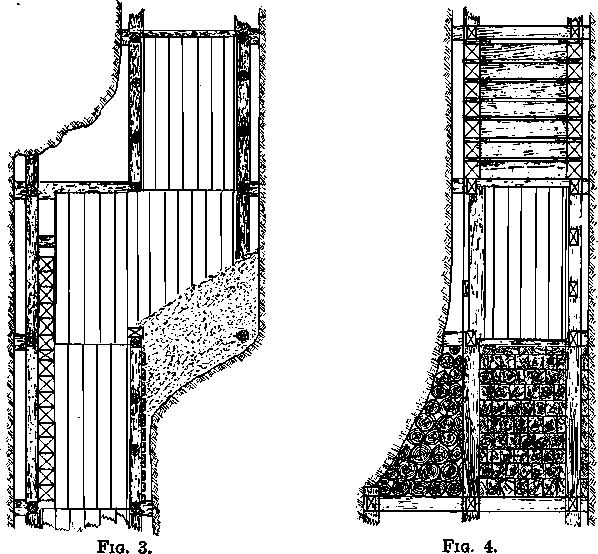
HANDLING ORE ON LEVELS
Underground haulage is divided into three classes; hand tramming, animal haulage and haulage by mechanical means. The amount of ore to be handled, length of haul, size of haulageway that can be readily maintained, and the grades to be overcome, determine which method is best adapted to any level.
Cars of the same type but of two sizes are used: The Anaconda No. 1, used in two mines, is 20-in. gage, holds 16 cu. ft., stands 3 ft. 10 in. above the rail, and is 2 ft. 2 in. wide. The Anaconda No. 2, used in twenty-eight mines, is 18-in. gage, holds 14 cu. ft., stands 3 ft. 10 in. above the rail, and is 2 ft. 0 in. wide. These cars are small for motor haulage but, because of the heavy ground, caused by settlement of stopes and sills in the wide orebodies, it has not been considered advisable to change to a larger car. Of the 7000 cars in use 3000 have roller-bearing wheels, which will be the standard equipment. The doors are in front but the cars may be swung and dumped to either side; when dumping at the side, a device prevents the car tipping back and injuring the trammer. The dumping lever stands in a vertical position at the back of the car. When it is moved through 15° the car is free to swing, but the door is held by its latch until the lever has moved its full travel. Cars recently introduced at two of the mines have foot levers operating very ingenious dump locks and door latches instead of the usual hand levers.
For hand tramming, 12 to 16-lb. rails are used; for animal haulage, 12, 16, and 25-lb. rails; and for locomotive haulage, 25-lb. rails. The switches
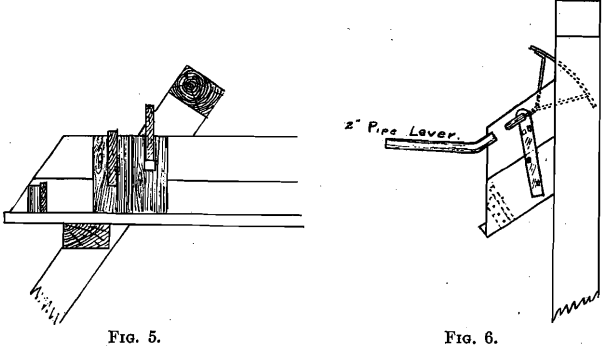
are forged from standard rail and in nearly all cases the frogs are riveted to ¼-in. plate. Long tongue and latch switches are used. The latch switches are made single and double throw, switch stands and spring latches of varying design are used. The track is laid on ties or runners. The ties are 3 by 10 by 30 in., 4 by 10 by 30 in. and 5 by 7 by 48 in.; and are spaced from 20 to 42 in.; the runners are 4 by 10 by 64 in. In most of the mines, ditches are carried under the center of the track; in the others, to one side of the track. The average grade on new levels is about 0.50 per cent, in favor of loads. Heavy and adverse grades in some mines are the result of careless work done in opening levels and of settlement of the ground near large orebodies. In some of the older mines, while shafts and stations show little settlement, the upper levels have settled several feet over old stopes. With extended workings, the cost of regrading a level is often prohibitive.
There are wide variations in the size and design of chute mouths at the different mines, the sizes run from 22 in. wide by 24 in. high to 36 in. wide by 20 in. high. Some have iron doors, as in Fig. 6, with levers; some have iron stop boards, with or without levers, but most of them have simple wooden stop boards. The chute bottoms are inclined from 35 to 45° to the horizontal, and are protected from wear by ¼-in. steel plate. The height of the lip varies from 4 to 18 in. above the side of the car. Wooden stop boards are used in nearly all cases where the trammer loads his own car.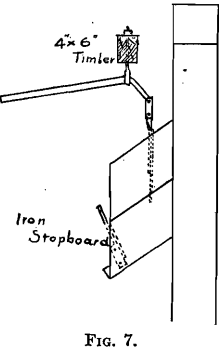
Hand and Animal Tramming
Ore is trammed by hand when opening new levels, on intermediate levels, and where the total amount to be handled is small or the distance not considerable. Less ore is transferred from chute to chute than in the past; nearly all ore is drawn directly from stope chutes by trains hauled by animals or locomotives.
Horses and mules haul about 15 per cent, of the ore. A horse lives nearly as long in a mine as on the surface, many working there from 10 to 15 years; regular feeding, careful attention by stable bosses and veterinarian, and occasional periods of rest on the surface contribute to this result.
A mine horse should be intelligent and kind, if he is not the time spent trying to train it will be wasted. The animal is usually driven single but for long hauls two or more horses or mules driven tandem have been used. Ten cars form the standard trip for one animal, but because of heavy grades shorter trains are used in some places. A good mine horse is worth from $100 to $150; harness, $35; collar, $8. A horse should be shod once a month if it is worked every day. The cost of a horse per day is as follows:

Care must be exercised in locating underground barns. The ideal place is just off a main air course, where the animals will be in good air but not in a draft and where the stable smells and vitiated air will go to the upcast shaft, without passing through places where men are at work. Provision must be made for drainage. The ground should be good, as a considerable opening must be made to accommodate two or more horses. Stalls should not be less than 4 ft. 6 in. wide by 16 ft. from the track. A stall should be provided for each horse needed, and space for oat box, hay, and water tank. Barns have water piped in when possible and are white-washed at regular intervals to keep them light and sanitary.
Mechanical Haulage
Electric trolley locomotives have been used in the Butte district for the past 14 years. All tracks and switches are bonded with No. 4 soft-copper wire. The minimum radius on turns is 10 ft.; and on switches, 15 ft. Haulageways are timbered not less than 4 ft. 2 in. by 7 ft. 8 in. and the trolley box is carried at least 6 ft. 8 in. above the rail. No. 0 hard-drawn trolley wire is carried by hangers spaced not over 20 ft. apart in a box consisting of a back board (2 by 6 in.) nailed to drift caps or sprags with 1 by 10 in. side boards. Direct current of 250 volts is supplied to each mine, or group of mines, by motor-generator sets located on the surface. Protection is given the men loading at the chutes by cut-out switches, or by insulating the wire at the chute mouths. Lights are placed every 100 ft. along haulageways and over switches. Signal systems employing colored lamps are used where more than one locomotive is worked on a level.
Seventeen mines use trolley locomotives—17 Jeffries, 24 General Electric, and 107 Westinghouse-Baldwins. These locomotives have the following dimensions:

Storage-battery Locomotives
Eight years ago storage-battery locomotives were tried by the Butte and Superior Co., as the condition of the haulageways, because of very wide orebodies and heavy ground, made haulage by the trolley-type impracticable. These locomotives will now be used in all mines; they do away with the overhead trolley wire, which is always a source of danger to the men, and is expensive to install and maintain. In some cases, it is impossible to maintain a drift of sufficient height and width to make haulage by the trolley type of locomotive safe. To put trolley locomotives on an old level, it is often necessary to retimber many of the old drifts before the trolley box can be built at a safe height. If 25-lb. rails are already laid, they must be bonded. The storage batteries require close attention by an electrician but, aside from this and the cost of replacing batteries, this locomotive is as easily maintained as the older type.
The cost per car of ore hauled by a Jeffrey storage-battery locomotive in the Black Rock Mine, Butte and Superior Co.,² is as follows:

The measurements of the locomotive are as follows:

During the year 1919,

The Anaconda Copper Mining Co. is replacing its trolley locomotives with storage-battery locomotives of the following measurements:

No other mechanical system of haulage is in use in the Butte District. Compressed-air locomotives were tried but their use was discontinued because of the danger and difficulty of maintaining high-pressure air lines underground.
STATIONS
The manner of handling ore trains on the stations is dependent on whether skips or cages are used to hoist the ore. If skips are used, the skip pockets are often large enough to store from 50 to 150 tons, although in some mines pockets holding one skipful are used and in others, on levels producing only a small tonnage, the cars are dumped directly into the skips. The cars from the trains are handled by station tenders (men working on cages) when the ore is hoisted by cage, dumped into the skip direct, and when pockets holding but one skip are used. With large skip pockets, the men on the train dump cars in the pockets; or if the tonnage is large enough, a man is kept on the station to dump the cars. The cars are dumped through holes covered by a grizzly with openings not less than 10 in.; in some cases as small an opening as 4 in. is used to sort out waste.
